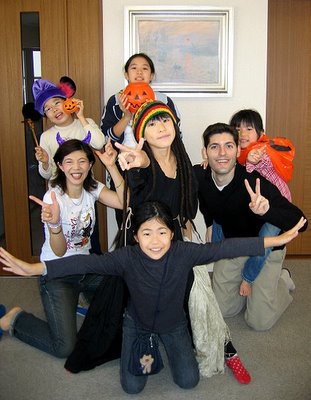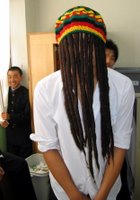 Holidays offer the chance to substitute the usual textbook drivel with creative lessons. In Japan, Halloween passes with little fanfare, except for at establishments catering to boozing foreigners. With some students only vaguely aware of the traditions, I kicked off classes by bringing the ghoulish cast of characters to life through colored chalk.
Holidays offer the chance to substitute the usual textbook drivel with creative lessons. In Japan, Halloween passes with little fanfare, except for at establishments catering to boozing foreigners. With some students only vaguely aware of the traditions, I kicked off classes by bringing the ghoulish cast of characters to life through colored chalk.
This created immediate cross-cultural confusion. After I sketched a ghost, a boy shouted out “octopus,”  so I added feet, only to draw more laughs – ghosts in Japan don't have them. I guess that’s also true of their American counterparts. Students guessed “bones” for my rendition of a skeleton. I then explained the superstition of black cats, which happens to be the name and logo of a parcel delivery service here.
so I added feet, only to draw more laughs – ghosts in Japan don't have them. I guess that’s also true of their American counterparts. Students guessed “bones” for my rendition of a skeleton. I then explained the superstition of black cats, which happens to be the name and logo of a parcel delivery service here.
A witch flying on a broomstick by moonlight was easily identified, so I went a step further to rile up the crowd. Straddling a broom borrowed from the class cleaning closet, I hopped across the room letting lose a high-pitched cackle. Even the sleeping kids (there’s always one or two) awoke to see the commotion. One boy in the front row started crying because he couldn’t stop laughing.
Trick-or-treating posed a challenge to explain. I acted it out by weaving a garbage pail through the aisles of desks, knocking on a few to ask for chocolate and candy. I got only blank stares in return, so the Japanese English teacher stepped in to translate.
At Kanokita School, Mr. Mochizuki shared a grisly Halloween story from 1992 when a 16-year-old Japanese exchange student in a white disco costume rang the wrong doorbell in search of a Halloween party in Baton Rouge. The startled proprietor yelled, “freeze,” but the boy mistook the command for “please,” and approached the man wielding a .44 Magnum, which he unloaded into the trespasser’s chest.
This tragedy reinforces the Japanese stereotype of trigger-happy Americans. Mr. Mochizuki was always dredging up the issue of guns in America, and capitalized on an incident that hit close to home to prove American barbarism. Arms folded, I held back disgruntlement and leaned against the door, watching young grins turn upside-down. We all gasped at the story’s exclamation point: 31-year-old Rodney Peairs was acquitted of manslaughter. I regained the floor and quickly shifted gears to build up anticipation for the unveiling of my Halloween costume, a Rastafarian wig friends purchased while vacationing in Jamaica. Scattered cheers answered my call for, “Do you want to see my costume?” so I excused myself and ducked into the hallway to throw on dreadlocks. I looked both ways to avoid embarrassment in front of Halloween-unaware teachers, or worse, district education officials on the lookout for signs of progress in the chaos at Kanokita.
I regained the floor and quickly shifted gears to build up anticipation for the unveiling of my Halloween costume, a Rastafarian wig friends purchased while vacationing in Jamaica. Scattered cheers answered my call for, “Do you want to see my costume?” so I excused myself and ducked into the hallway to throw on dreadlocks. I looked both ways to avoid embarrassment in front of Halloween-unaware teachers, or worse, district education officials on the lookout for signs of progress in the chaos at Kanokita.

 What the heck was sensei wearing on his head? The puzzling costume produced amusing guesses, most commonly that I was a girl. Other mistaken identities included, Mexico, Medusa, and tree roots. One girl was in favor of the new look: “it suits you,” she said. The girls wanted to touch my locks while the boys wanted to try on the wig, which played perfectly into my plan of getting photo-ops.
What the heck was sensei wearing on his head? The puzzling costume produced amusing guesses, most commonly that I was a girl. Other mistaken identities included, Mexico, Medusa, and tree roots. One girl was in favor of the new look: “it suits you,” she said. The girls wanted to touch my locks while the boys wanted to try on the wig, which played perfectly into my plan of getting photo-ops.
The dreads shed and scratched, but I kept the wig on for the duration of the class for amusement’s sake. I tied the hair into a bun to get it off my shoulders. Sometimes I pretended to eat it. Sticking a dreadlock inside each nostril was a crowd pleaser.
In religious holiday news, on October 13 I informed Mr. Mochizuki that I would not be eating lunch with the children that day. I would not be eating lunch at all because of Yom Kippur, the Jewish Day of Atonement.
No, I was not on a diet, did not have a stomachache, and was not about to undergo a medical procedure. Explanation of why I was fasting was more difficult to translate than what the students surmised.
Although not religious, I make an effort on the holiest day of the Jewish calendar. But neither Jews nor Judaism rang a bell with Mr. Mochizuki. Not even after looking up the translation in the dictionary. After I convinced him that Judaism was not a sect of Christianity, he asked, “Are you Islam?”
I groaned silently, and tried a different tactic. “Do you know the country of Israel?” No. “How about the Holocaust?” Curious stare. “You know, how Hitler killed 6 million people in Europe, and well, most of them were Jews?” “Ahh, okay,” the teacher said, as if recalling some trivial factoid from the recesses of his brain. “Please tell the children some information.” “About the Holocaust!?” Thankfully, classes last only 50 minutes.
Around the corner is Thanksgiving, which while my favorite holiday on the calendar of either country, is rather boring to explain to Japanese students. We consume truckloads of turkey and harvest vegetables in the company of our dysfunctional extended families. Scrawling a turkey on the blackboard invited creative interpretations of Thanksgiving’s iconic bird, but fortunately peacock, ostrich, and pigeon do not make the menu at my family’s dinner. Pigeon pie, anyone?
Saturday, November 05, 2005
Halloween: Octopus, Medusa and Manslaughter
Posted by
ジェフリー
at
8:45 AM
![]()
Labels: Mochizuki, teaching (general)
Subscribe to:
Post Comments (Atom)



4 comments:
excelente!!!
hey, what's with the "v for victory" signs the kids always flash in photos??? is that some sort of gang sign? ...
The "peace" sign is actually a pose for the camera. Boys and girls of any age do it automatically when in the presence of a camera. Just another Japanese quirk.
I think the Japanese must have seen too many of those "applejacks" commercials ...
Post a Comment